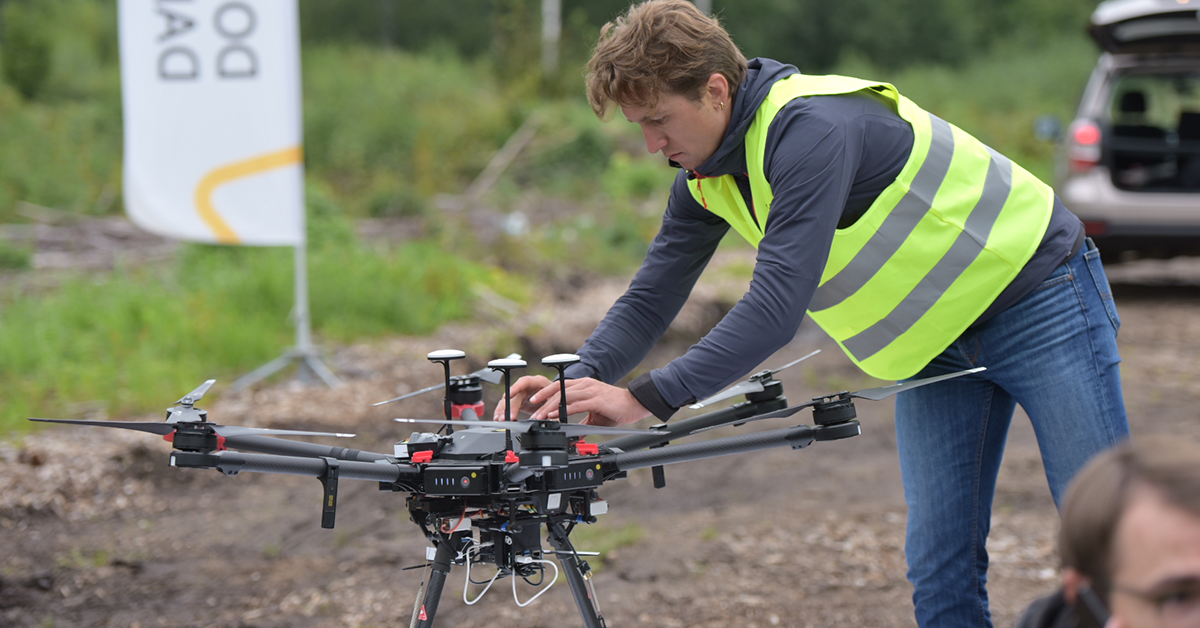
Commercial drones can help many industries by reducing costs, improving safety, efficiency and delivering a variety of new services not previously possible. The total number of drones will reach to 86.5 million by 2025[1] and total drones value chain revenue will grow to over $14 billion in 2025 worldwide. Despite this there are still many challenges that the industry needs to tackle.
With the purpose to support safe Beyond Visual Line Of Sight (BVLOS) operation through cellular connectivity on September 2, 2020, mobile operator LMT successfully completed the first-ever cross-border drone flight conducted entirely over the mobile network. The drone was flown from Latvia to Estonia without losing mobile network connectivity, demonstrating the power of GSM networks to fully enable drone missions well beyond visual line of sight (BVLOS) providing connectivity, identity and navigation. Safely and successfully navigating drones beyond line sight is essential to accelerate the growth cellular connected drones and deliver valuable remote delivery, monitoring and communication services.
The flight started in Latvia and ended in Estonia, with the multirotor drone traveling a total of 8km. The drone was equipped with two SIM cards – one from each country – and switched from one to the other mid-flight as it crossed the border. To accomplish the BVLOS flight, UA ground control software (UgCS) was used in conjunction with a custom-built command and control modem built in collaboration with SPH Engineering. The cross border demonstration showed that it is technically feasible to switch networks within a few milliseconds, which allows the drone operator to safely maintain control of the UA during the whole flight without losing connection.
This demonstration was a meaningful step toward understanding the technological capabilities of cellular connected drones, expanding the scope of potential applications. One current example is linked to Rail Baltica, the international railway project spanning the Baltic states, which is considering 5G technologies for potential use in railway infrastructure. The ability to easily cross borders, while maintaining connectivity, make it possible for drones to participate in railway safety measures by monitoring and maintaining tracks in border regions.
“Currently, the majority of drone solutions are based on WiFi connections or other frequencies provided for drone management. In contrast to the mobile network, those are limited in their range. If there’s sufficient coverage in the air, the mobile network can ensure uninterrupted connectivity throughout the entirety of its flight, which significantly improves safety. LMT’s strong network coverage makes drone flight and other 5G use case testing a possibility. As a result, LMT is able to significantly contribute to pushing forward the global understanding of what mobile networks are capable of.” – Ingmars Pukis, VP and Member of the Board of LMT
“CAA supports the development of a UAV system in Latvia. Collaboration among the public and private sectors is crucial for R&D to result in the creation of new services, particularly for those that are connected with higher risk, to maintain or even increase the level of flight safety. When conducting flights beyond the line of sight it is important to avoid other objects both in the air and on the ground. An equally relevant topic is that of identification, which makes it possible to follow the trajectory of the flight and in some cases inform about potential surrounding threats. Through using a variety of risk-minimizing approaches it’s been made possible to authorize a cellular connected drone flight, which offers a new technological solution for cross-border flights.” – Ilmārs Ozols, head of the UAV flight safety department at the Civil Aviation Agency of Latvia
The GSMA believes that mobile networks are a crucial component of enabling commercial drone operation at low altitude Beyond Visual Line Of Sight (BVLOS).
The GSMA is constantly looking on how mobile networks are helping to support a variety of new innovative solutions beyond the traditional consumer type of communication. As part of this effort the GSMA created a Drone Interest Group (DIG) consisting with over 50 members, including LMT, that are contributing to support drone operation through cellular connectivity. The interest group brings together mobile operators, aviation industry participants to develop recommendations on how to incorporate drones into airspace and how to use the mobile network as a communication channel for aviation usage.
In addition, the GSMA and the Global UTM Association (GUTMA) has set up joint drone working group the Aerial Connectivity Joint Activity (ACJA).
ACJA is a forum where members of the telecom, including LMT, and aviation industries work together to unlock the full potential of unmanned aerial vehicles (also known as simply drones) by allowing them to operate beyond the pilot’s visual line of sight.
[1]
https://www.gsma.com/iot/wp-content/uploads/2019/02/22166-Connected-Drones-Infographic-v3-002.pdf